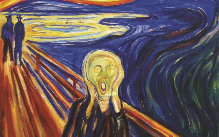







Defining Art
Art is a diverse range of human activities in creating visual, auditory or performing artifacts (artworks), expressing the author's imaginative or technical skill, intended to be appreciated for their beauty or emotional power. In their most general form these activities include the production of works of art, the criticism of art, the study of the history of art, and the aesthetic dissemination of art. (Wikipedia)
Individual Quotes -
“Art,” as a verb, is a basic need of mine like eating, loving, talking—but mostly it is about making. I am compelled to make things: to draw, paint, and take photographs. I dream in images. I react to other images. I see patterns and colours before I read words. Making art drives my being—I cannot go too long without doing it—art sustains me. (Diane Burko)
“Painting is poetry that is seen rather than felt, and poetry is painting that is felt rather than seen.” (Leonardo da Vinci)
"If I were called upon to define briefly the word Art, I should call it the reproduction of what the senses perceive in nature, seen through the veil of the soul." (Paul Cezanne)
“There are painters who transform the sun to a yellow spot, but there are others who, with the help of their art and their intelligence, transform a yellow spot into sun.” (Pablo Picasso)
“When I say artist I mean the one who is building things … some with a brush – some with a shovel – some choose a pen.”
(Jackson Pollock)
Some Important Ideas about Making Art with Others
(From Susan Schwake in Art for Kids)
Each person's work should be wholly his or her own. Don't work on someone else’s art. Use thoughtful language when working with others. For example, “tell me about your painting" works better than "What is that?"
Always use the best. materials that you can lay your hands on for each art-
Don't worry about wrecking a new paper or canvas. These items can be reused—torn up for collage, primed over with gesso, or printed over.
Promote fearlessness.
Embrace individual style. Respect each other's differences.
Try out your own ideas. Have fun! The most important lessons in art are ones that you discover about yourself in the process. Be brave, experiment, fear no art!
VISUAL ARTS
(From 100,000 Things you need to Know -
Here we have anything that people perceive exclusively or mainly through sight, so it encompasses movies, TV shows, paintings, sculptures, and buildings. Moreover, it's not only the works themselves, but also the people who created them: artists, photographers, directors, and actors. Find out the techniques that made Caravaggio and others great painters, which ancient Roman architect influenced the design of the White House, what Hitchcockian skill Steven Spielberg employed to make Jaws scary, which was-
INTRODUCTION
(From Eyewitness Companions Art by Robert Cumming, an excellent compact but extensive coverage. Also the following, ‘What is Art’ and ‘The Artist through History)
My first job in the art world was at the Tate Gallery, as a new member of a small team whose task was to stand in front of the works on display and explain them to the public. I soon learned that four questions were asked over and over again:
1. What should I look for? What are the key features in a Picasso, a Rembrandt, a Raphael, a Turner?
2. What is going on? What is the story? Who is Hercules? What is the Nativity? Who is that girl with a broken wheel? Who is the man abducting the woman who looks like a tree? Does that big red square mean anything?
3. What is its value? Am I looking at £10? £10,000? £1 million? £10 million?
4 Is it any good? And, in front of a pile of bricks or an unmade bed, am I being taken for a ride?
WHAT is ART?
Very few artists fit the stereotype of suffering for their art, starving in an unheated garret, producing one
unrecognized masterpiece after another, and finally achieving recognition on their deathbed. The image of
the artist as a lonely, neglected ,genius is attractive but misleading. The reality is much more prosaic.
Most artists have been skilled in their trade, hard-
THE ARTIST THROUGH HISTORY
This is not to say that the role of the artist does not change. It is possible to pinpoint three turning points when the role of the artist and his and her relationship with the rest of society altered significantly.
In Ancient, Classical, and Medieval times, artists were essentially skilled craftsmen working for an employer such as a monarch, the Church, or a corporate organization. Their activities were supported and regulated by a professional body or guild.
At the beginning of the 16th century, Leonardo da Vinci argued that the artist should be treated as the social and intellectual equal of aristocrats and scholars. The great artists of the High Renaissance shared this aspiration, and the majestic flowering of their art proves how successful they were in establishing this role. It suited both artist and patron and endured right up to the end of the 19th century. It allowed artists to play the fullest possible role in society, becoming the confidants of kings and popes, and sometimes even acting as diplomats and courtiers.
The French Revolution of 1789 ushered in profound political and social changes. The privileged world of monarchy and aristocracy began to wane. With a new sense of individual liberty in the air, art attracted new personalities who previously would have ignored an artistic life. The Romantic spirit exploited this freedom to express individual emotions, and to create art about personal experiences. The Classical tradition, with its admiration for antiquity and disciplined professional training, continued to flourish alongside Romanticism, but it was in decline. This spirit of independence led to a turning point in the second half of the 19th century, and to a new role for the artist. The change was most forcibly expounded by the radical French painter, Gustave Courbet, who argued that the true artist should be an outsider to the rest of society, free of all normal social conventions and at liberty to set his or her own rules. The idea was potent, particularly to the disaffected young, many of whom wished to establish a new art that would address issues at the heart of industrial society and the new awareness of human relationships and emotions that were revealed, for example, by Freudian analysis. It was a necessary condition for the development of Modern Art, and led to a rare chapter in the history of art in which the prime motivation of the artist was not widespread recognition, professional advancement, riches or social success, but a desire to reform society and human relationships and literally to change the way we see the world.
And some final Individual Quotes
“Art washes away from the soul the dust of everyday life.” (Pablo Picasso)
“A man should hear a little music, read a little poetry, and see a fine picture every day of his life, in order that worldly cares may not obliterate the sense of the beautiful which God has implanted in the human soul.” (Johann Wolfgang von Goethe)
“Anybody can look at a pretty girl and see a pretty girl. An artist can look at a pretty girl and see the old woman she will become. A better artist can look at an old woman and see the pretty girl that she used to be. But a great artist-
